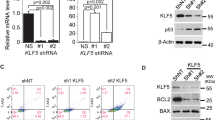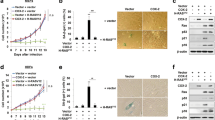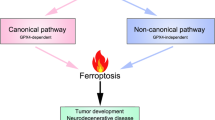Abstract
Nitric oxide (NO) is an efficient inhibitor of cell proliferation. Here we show that part of the antiproliferative activity of NO in fibroblasts is mediated through p53 signaling pathway. Cells from p53−/− knockout mice are compromised in their ability to stop dividing in the presence of NO. NO strongly induces expression of genes which are transcriptional targets of p53, and p53 is necessary for some, but not all, of the transcription activation effects of NO. Furthermore, NO strongly increases the cellular level of p53 protein. Since phosphorylation of particular residues of the p53 molecule has been correlated with its functional activity, we determined the phosphorylation pattern of p53 molecule after exposure to NO and compared it with the phosphorylation patterns that develop upon treatment with gamma-irradiation, UV light, and adriamycin. We found that NO induces a specific signature pattern of p53 phosphorylation, distinct from the patterns evoked by other inducers. This study suggests that NO activates specific signaling pathways that may partially overlap, but that do not coincide, with signaling pathways activated by other known inducers of p53 activity.
This is a preview of subscription content, access via your institution
Access options
Subscribe to this journal
Receive 50 print issues and online access
$259.00 per year
only $5.18 per issue
Buy this article
- Purchase on Springer Link
- Instant access to full article PDF
Prices may be subject to local taxes which are calculated during checkout





Similar content being viewed by others
References
Bredt DS and Snyder SH. . 1994 Annu. Rev. Biochem. 63: 175–195.
Brune B, von Knethen A and Sandau KB. . 1998 Eur. J. Pharmacol. 351: 261–272.
Canman CE, Lim DS, Cimprich KA, Taya Y, Tamai K, Sakaguchi K, Appella E, Kastan MB and Siliciano JD. . 1998 Science 281: 1677–1679.
El-Deiry WS. . 1998 Semin. Cancer Biol. 8: 345–357.
Enikolopov G, Banerji J and Kuzin B. . 1999 Cell Death Differ. 6: 956–963.
Forrester K, Ambs S, Lupold SE, Kapust RB, Spillare EA, Weinberg WC, Felley-Bosco E, Wang XW, Geller DA, Tzeng E, Billiar TR and Harris CC. . 1996 Proc. Natl. Acad. Sci. USA 93: 2442–2447.
Garg UC and Hassid A. . 1990 Biochem. Biophys. Res. Commun. 171: 474–479.
Garthwaite J and Boulton CL. . 1995 Annu. Rev. Physiol. 57: 683–706.
Giaccia AJ and Kastan MB. . 1998 Genes Dev. 12: 2973–2983.
Gibbs SM and Truman JW. . 1998 Neuron 20: 83–93.
Gross SS and Wolin MS. . 1995 Annu. Rev. Physiol. 57: 737–769.
Jacks T, Remington L, Williams BO, Schmitt EM, Halachmi S, Bronson RT and Weinberg RA. . 1994 Curr. Biol. 4: 1–7.
Ishida A, Sasaguri T, Kosaka C, Nojima H and Ogata J. . 1997 J. Biol. Chem. 272: 10050–10057.
Keefer LK and Wink DA. . 1996 Adv. Exp. Med. Biol. 387: 177–185.
Keefer LK, Nims RW, Davies KM and Wink DA. . 1996 Methods Enzymol. 268: 281–293.
Kuzin B, Roberts I, Peunova N and Enikolopov G. . 1996 Cell 87: 639–649.
Kwon NS, Stuehr DJ and Nathan CF. . 1991 J. Exp. Med. 174: 761–767.
Lepoivre M, Chenais B, Yapo A, Lemaire G, Thelander L and Tenu JP. . 1990 J. Biol. Chem. 265: 14143–14149.
Levine AJ. . 1997 Cell 88: 323–331.
Lipton SA. . 1999 Cell Death Differ. 6: 943–951.
Lu H, Taya Y, Ikeda M and Levine AJ. . 1998 Proc. Natl. Acad. Sci. USA 95: 6399–6402.
Madden SL, Galella EA, Zhu J, Bertelsen AH and Beaudry GA. . 1997 Oncogene 15: 1079–1085.
Mannick JB, Asano K, Izumi K, Kieff E and Stamler JS. . 1997 Cell 79: 1137–1146.
Messmer UK and Brune B. . 1996 Biochem. J. 319: (Pt 1) 299–305.
Nathan C and Xie QW. . 1994 Cell 78: 915–918.
Nicotera P, Bernassola F and Melino G. . 1999 Cell Death Differ. 6: 931–933.
Papapetropoulos A, Desai KM, Rudic RD, Mayer B, Zhang R, Ruiz-Torres MP, Garcia-Cardena G, Madri JA and Sessa WC. . 1997 Am. J. Pathol. 150: 1835–1844.
Peunova N and Enikolopov G. . 1995 Nature 375: 68–73.
Poluha W, Schonhoff CM, Harrington KS, Lachyankar MB, Crosbie NE, Bulseco DA and Ross AH. . 1997 J. Biol. Chem. 272: 24002–24007.
Polyak K, Xia Y, Zweier JL, Kinzler KW and Vogelstein B. . 1997 Nature 389: 300–305.
Prives C. . 1998 Cell 95: 5–8.
Shieh SY, Ikeda M, Taya Y and Prives C. . 1997 Cell 91: 325–334.
Siliciano JD, Canman CE, Taya Y, Sakaguchi K, Appella E and Kastan MB. . 1997 Genes Dev. 11: 3471–3481.
Stamler JS. . 1994 Cell 78: 931–936.
Stamler JS and Feelisch M. . 1996 Methods In Nitric Oxide Research. Stamler JS and Feelisch M. (eds). John Wiley and Sons: New York. pp. 521–540.
Tamir S, deRojas-Walker T, Wishnok JS and Tannenbaum SR. . 1996 Methods Enzymol. 269: 230–243.
Waterman MJ, Stavridi ES, Waterman JL and Halazonetis TD. . 1998 Nat. Genet. 19: 175–178.
Wingrove JA and O'Farrell PH. . 1999 Cell 98: 105–114.
Acknowledgements
We thank members of the Enikolopov Laboratory for help and advice. We are grateful to Julian Banerji for his invaluable advice and critical reading of the manuscript. This work was supported by grants from the NIH, the Charles Henry Leach Foundation and the Seraph Foundation to G Enikolopov and from the Henry Wendt Fellowship Program to N Nakaya. SW Lowe is a Rita Allen Foundation Scholar.
Author information
Authors and Affiliations
Rights and permissions
About this article
Cite this article
Nakaya, N., Lowe, S., Taya, Y. et al. Specific pattern of p53 phosphorylation during nitric oxide-induced cell cycle arrest. Oncogene 19, 6369–6375 (2000). https://doi.org/10.1038/sj.onc.1204100
Received:
Revised:
Accepted:
Published:
Issue Date:
DOI: https://doi.org/10.1038/sj.onc.1204100
Keywords
This article is cited by
-
M1 macrophage dependent-p53 regulates the intracellular survival of mycobacteria
Apoptosis (2020)
-
Activation of the steroid and xenobiotic receptor, SXR, induces apoptosis in breast cancer cells
BMC Cancer (2009)
-
Association of the ERK1/2 and p38 kinase pathways with nitric oxide-induced apoptosis and cell cycle arrest in colon cancer cells
Cell Biology and Toxicology (2005)
-
Nitric oxide induces phosphorylation of p53 and impairs nuclear export
Oncogene (2003)
-
Nitric oxide: NO apoptosis or turning it ON?
Cell Death & Differentiation (2003)



